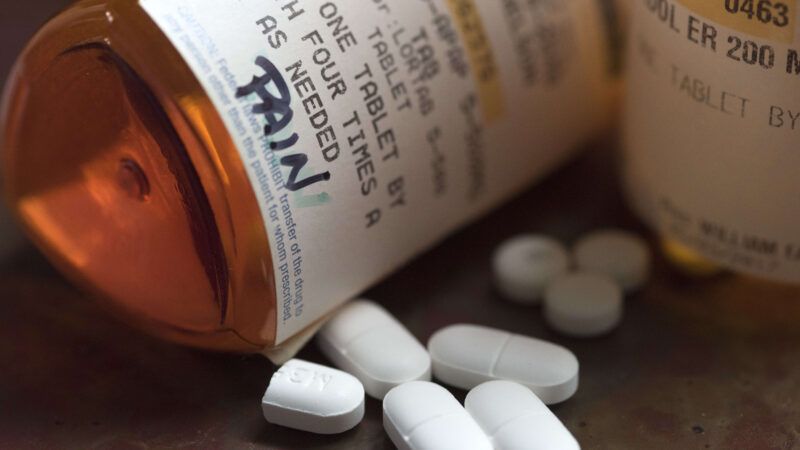America's Failed Opioid Policy Drove the Tulsa Shooter to Violence
Doctors can’t help people in pain because of restrictive opioid policy.

There's an old adage among physicians that "the patient can always hurt you more." This refers to the emotional toll personal mistakes and surgical complications can have on physicians when treating ill patients. A recent event has given that old adage a new, more tangible meaning.
Michael Louis, a patient at a Tulsa, Oklahoma, medical office, underwent spinal surgery last month. After being released on May 24, he repeatedly called the clinic to get further treatment for his lasting pain to no avail. On June 2, he targeted and killed his surgeon, Preston Phillips, before killing himself in a mass shooting.
While this story is shocking, it is not unpredictable. Doctors are often threatened by patients in immense pain after they are abruptly cut off from their opioid medications. How did we get here?
Policy makers and health care practitioners tend to misinterpret and misapply the 2016 Centers for Disease Control and Prevention (CDC) guideline for prescribing opioids for chronic pain, taking for a mandate what was meant as a general rule of thumb. Released as a measure to combat the overdose crisis, the report recommended imposing limits on the number of opioid prescriptions doctors could provide. This led many doctors, intimidated by possible consequences, to abruptly taper patients off pain medicine that has worked to treat and control pain for years. Horror stories about doctors being arrested or having their licenses suspended have led many physicians to give up treating pain altogether, refusing to see pain patients.
Misguided drug policy has stigmatized chronic pain patients, who are often suspected of being "drug abusers." And many doctors are just as misguided as journalists and politicians in their understanding of the pharmacology of opioids, as well as the difference between chemical dependency and addiction.
Because the government and medical boards limit surgeons' ability to prescribe opioids, surgeons, like us, can no longer treat a patient's complex pain using our best clinical judgment without administrative oversight. This system builds a wall between patients and their doctors, creating an adverse environment. This is not what we expected when we took the Hippocratic oath.
Up to 40 percent of spinal deformity patients have had some sort of spinal surgery in the past (performed by a spinal surgeon like Phillips or like Richard Menger, one of the authors of this article), meaning many of them are on opioids already. Recovery from these surgeries can take anywhere from three months to a year. While these patients go through a painful recovery, spine surgeons aren't always able to treat pain in a streamlined manner; we are required to prescribe only a limited amount of opioids. Oftentimes routine refill mechanisms are not available, and patients needing refills must be seen in person or prescribed medicine via an elaborate electronic co-signing system. Patients have to either run back and forth to the office or navigate an electronic prescription process sometimes between multiple pharmacies trying to connect to the e-software. Surgeons are frustrated. The staff faces burnout. And the patients have no efficient way to relieve their pain.
Patients often blame their doctor for their untreated pain. As patients become desperate for relief, they sometimes turn to the black market if their pharmacy can't fill the prescription in time. While lawmakers can try to regulate medication, they cannot regulate pain. Government attempts to combat the opioid crisis by reining in opioid supply and prescriptions have failed. By 2020, opioid prescription volume dropped roughly 60 percent from its peak in 2011, yet overdose rates have skyrocketed. Data collected from the CDC and the National Survey on Drug Use and Health show no association between the volume of opioid prescriptions and the nonmedical use or addiction in persons over the age of 12.
Although the reduction in opioid prescriptions has had no impact on overdose deaths from medically used opioids, the same cannot be said for opioids used nonmedically. It is now widely accepted that as the supply of relatively safe prescription drugs was slashed, nonmedical users have turned to heroin and, more recently, fentanyl, which was responsible for 87 percent of the 30,000-spike in drug overdose deaths in 2020. And fentanyl, cocaine, and methamphetamines were responsible for nearly all overdose deaths in 2021.
There is no clear definition of overprescribing. Yet policy makers keep doubling down on a misguided mission to reduce or eliminate opioid prescribing, putting patients back in miserable pain and mental anguish, driving some to suicide and others to the black market. Now, it may have driven one person to homicide.
All the while, overdoses soar among the population of nonmedical users who long ago moved on to heroin and fentanyl. Unfortunately, policy makers continue to believe the overdose crisis was caused by doctors treating their patients in pain when the real cause is drug prohibition and the dangerous black market it creates.
Show Comments (107)